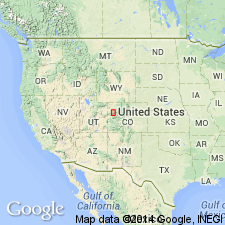
- Usage in publication:
-
- Coughs Creek Tongue*
- Modifications:
-
- Named
- Dominant lithology:
-
- Marl
- Sandstone
- Siltstone
- AAPG geologic province:
-
- Piceance basin
Summary:
Named as a tongue of Green River Formation for Coughs Creek, tributary to Cow Creek which is a tributary of Piceance Creek. Type section measured on west side of Cow Creek in SW1/4 SE1/4 sec 12, T4S, R95W, Rio Blanco Co, CO in the Piceance basin. Is 110.8 ft thick at type where it: 1) overlies and underlies Uinta formation; and 2) consists of interbedded tan siltstone, gray to tan marlstone, and orange to tan, very fine grained sandstone. Some of the marlstone is laminated and in thin beds. Some of the sandstone is very calcareous. Probably joined the main body of the Green River in the southern part of the Piceance basin but has been eroded from that area since. Is a conspicuous marker over the east-central and southern Piceance basin. Ranges between 50 and 85 ft thick. Is separated from the Parachute Creek Member of the Green River by about 400 ft of Uinta. Cross section, measured section. Is overlain by about 600+ ft of Uinta Formation. The Uinta contains abundant carbonaceous trash. Of Eocene age.
Source: GNU records (USGS DDS-6; Denver GNULEX).
For more information, please contact Nancy Stamm, Geologic Names Committee Secretary.
Asterisk (*) indicates published by U.S. Geological Survey authors.
"No current usage" (†) implies that a name has been abandoned or has fallen into disuse. Former usage and, if known, replacement name given in parentheses ( ).
Slash (/) indicates name conflicts with nomenclatural guidelines (CSN, 1933; ACSN, 1961, 1970; NACSN, 1983, 2005, 2021). May be explained within brackets ([ ]).

